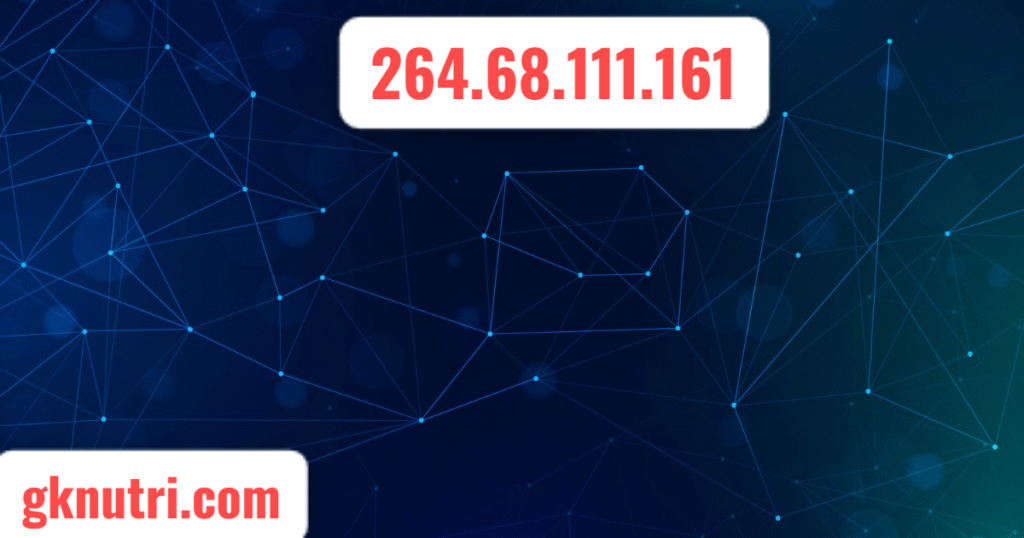
Introduction to 264.68.111.161 and IP Address Basics
The world today runs on data. From the moment you open your browser to when you stream a movie or send a message, you are using an IP address. One such example is 264.68.111.161. But here’s the catch: this IP isn’t actually valid in real networks. So, why does it matter? Understanding this address helps you grasp how Internet Protocol works and the risks of IP exposure. It’s a powerful tool that connects us—but it can also expose our digital identity if misused.
Most people think of IPs as just numbers, but they are central to IP monitoring, IP tracking, and even network surveillance. Knowing how an address like 264.68.111.161 works (or fails to work) improves your cybersecurity posture. Plus, it shows the need for tools like IP masking tools, firewall protection, and Virtual Private Network (VPN) setups.
What is an IP Address?
An IP address is a set of numbers that identifies devices on a network. Just like your home address helps a mailman reach you, an IP helps computers find each other. But here’s the thing: IPs follow strict rules.
264.68.111.161 may look normal, but it falls outside valid IPv4 ranges. That tells you something is off. Knowing these limits helps prevent mistakes, fake addresses, and IP-based attacks. Plus, it helps in understanding IP data security and cyber hygiene practices.
IPv4 vs. IPv6: Which One Matters Now?

The internet mostly runs on two types of IPs: IPv4 and IPv6. IPv4 is older and uses four numbers from 0 to 255. That’s why 264.68.111.161 is invalid—264 is not allowed. On the other hand, IPv6 uses longer alphanumeric strings to allow more unique addresses.
This shift to IPv6 is about more than numbers—it’s about keeping up with demand and improving IP security protocols. As more devices go online, IP tracking becomes tougher. Tools like device fingerprinting and DNS leaks monitoring help ensure online safety.
Structure Behind 264.68.111.161
To understand the address 264.68.111.161, you need to understand how IPv4 addresses are built. The correct format is four numbers, each from 0 to 255. So, any number above 255, like 264, is a red flag.
| Octet | Valid Range |
| 1st | 0–255 |
| 2nd | 0–255 |
| 3rd | 0–255 |
| 4th | 0–255 |
Using this knowledge, we can easily say 264.68.111.161 is not a valid IP. However, it may still show up in tutorials, scams, or testing environments. Knowing its invalidity helps prevent malicious activity.
Why Invalid IPs Still Appear
So why do invalid IPs like 264.68.111.161 show up online? Sometimes, they’re used as placeholders or in cybersecurity simulations. In other cases, attackers may use fake IPs to trick people or to hide real IP logs analysis.
That’s why it’s important to verify every IP you deal with—especially when you see suspicious online activity. Whether you’re working in cybercrime prevention or setting up a network, valid IPs matter. Using fake IPs could mess up configurations and make systems vulnerable to IP-based attacks.
Public vs. Private IP Addresses
Not all IPs are the same. Some are public, and others are private. Public IPs are assigned by your ISP (Internet Service Provider) and can be seen online. Private IPs are used inside your home or office networks.
Knowing the difference matters. Public IPs are exposed to cyber threats, while private IPs are hidden behind routers and firewalls. But remember: even private IPs can leak through DNS leaks or IP exposure incidents. That’s where IP masking tools and proxy servers come into play.
Cybersecurity Risks of Faulty IPs
Let’s be honest. If you’re not careful with IPs, you’re opening yourself to danger. Using or trusting invalid addresses like 264.68.111.161 could lead to cyber threats, data leaks, or fake routing.
This is why businesses and users should invest in firewall protection, data encryption, and Virtual Private Network (VPN) tools. These help shield your digital identity from attackers and prevent real-time IP logging.
Cyber Hygiene Practices You Should Follow
Online protection starts with strong cyber hygiene practices. These habits are simple but powerful. You can:
- Use a VPN whenever browsing public networks
- Routinely scan your network for fake IPs
- Block malicious activity with updated antivirus
- Set up firewall protection on all devices
- Monitor IP logs analysis regularly
With just these five steps, you’ll build strong defenses. Even fake IPs like 264.68.111.161 won’t pose a risk if your setup is solid.
Tools for IP Lookup and Validation
Wondering how to check if an IP is valid? There are tools for that. Sites like IPWHOIS and MaxMind offer IP geolocation, validation, and even ISP lookup. These tools reveal your user location data, and also expose invalid ones.
But don’t stop there. Use proxy servers or a VPN to limit what others can see about you. These help hide your IP address and protect your digital footprint.
Common Misunderstandings Around IPs
Many people confuse IP address with MAC address or think their IP never changes. But that’s not true. IPs can be static (fixed) or dynamic (change over time).
Also, don’t fall for websites showing random IPs like 264.68.111.161 as real addresses. Always use IP tracking tools to verify. Mistaking these details can risk your IP data security and make you vulnerable to cybercrime prevention gaps.
Real-Time Logging and IP Monitoring
Modern tech allows for real-time IP logging. That means your actions, location, and device types are constantly tracked. This is done by websites, ISPs, and ad networks.
If that scares you, you’re not alone. To stay protected, use IP masking tools and limit sharing your digital identity. Combine these with IP security protocols for the best results.
Using VPNs and Proxy Servers
When you’re worried about anonymity online, there are two top tools: VPNs and proxy servers. Both help hide your IP, but in different ways.
- VPNs encrypt your entire connection
- Proxy servers mask only specific apps or sites
- VPNs offer stronger data encryption
- Proxies are faster but less secure
- Both help in reducing IP exposure
Choose one based on what you do online. For high-risk work or browsing, go with a VPN.
How ISPs Log and Track Your Data
Your ISP (Internet Service Provider) keeps track of your IP. Every website you visit, they know. That’s why some people are uneasy about network surveillance. These logs are stored and can be accessed by authorities or sold to marketers.
This is why you need IP masking tools, encrypted DNS, and even device fingerprinting blockers to protect your online safety.
Device Fingerprinting: The Invisible Threat

Device fingerprinting is a method used by websites to know who you are. Even if you change your IP address, they can track your screen size, fonts, browser, and more.
That’s why just using a VPN isn’t enough. Combine it with anti-tracking tools and cyber hygiene practices to stay fully secure.
Conclusion: Why 264.68.111.161 Still Matters
Even though 264.68.111.161 is not valid, it teaches us something powerful. Knowing how IPs work, what risks exist, and how to stay safe is more than tech talk—it’s survival in the digital age.
Whether you’re a business, a student, or a casual user, protecting your digital footprint starts with understanding IPs. Practice online safety, follow IP security protocols, and stay alert to cyber threats.
FAQs
What makes 264.68.111.161 invalid?
The first number, 264, is above the allowed IPv4 range (0–255). This makes it invalid in any real network setting.
Can invalid IPs still pose a threat?
Yes. Even fake IPs can be used in scams or malware. Always verify and monitor them using IP tracking tools.
How do I stay anonymous online?
Use a trusted Virtual Private Network (VPN), combine it with firewall protection, and adopt strong cyber hygiene practices.



